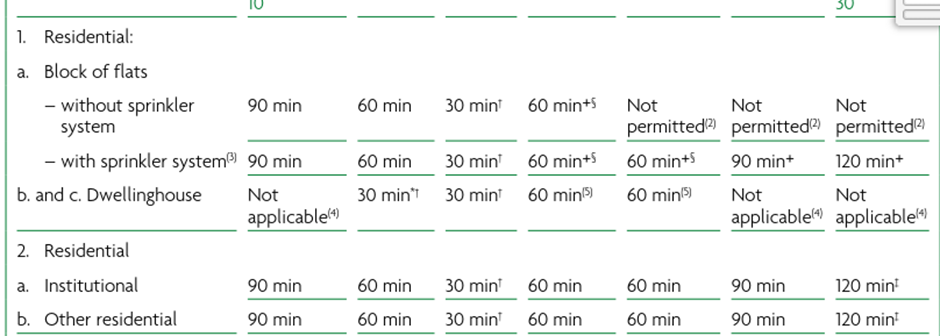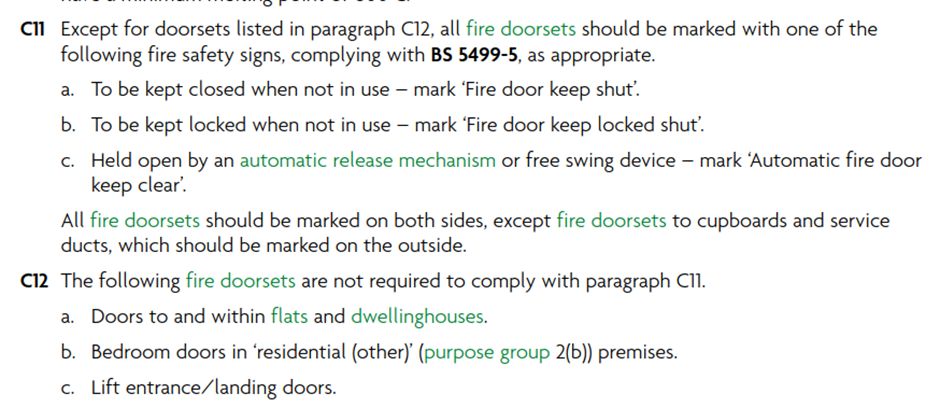
Mike North
-
Posts
210 -
Joined
-
Last visited
Posts posted by Mike North
-
-
Mag locks are perfectly acceptable as long as the door cert allows them.
Care must be taken when they are used on an escape route, they should fail safe in the unlocked position when the fire alarm is activated.
-
Basically, if the landlord lets the tenancy out to a group of individuals as a single entity then it is shared accommodation, if the landlord lets individual rooms out then it’s an HMO.
But you need legal advice
-
1550mm divided by 5mm equalling 310 people
-
A proper fire risk assessment (which is a legal requirement) will tell you what you need to do
-
This may be of interest Furniture.
-
Yes, anyone can maintain the doors. Who are you going to get to sign them off? As I suspect that the firm you hired to inspect them wont.
By the way, why did you go to a FIRAS Registered company to inspect the doors if Joe Blogs are going to maintain them
-
Its finding the right surveyor who is use to dealing with historical buildings.
By taking a holistic approach to an overall fire risk assessment you can let somethings slide and beef others up, an example would be to put smoke heads either side of the door in lieu of closing the gaps. Of course this is all dependant of the risks and the purpose group of the property
-
Without looking at the building or some form of drawing I could not tell you, the listing part does not trump the RRO, the does however make it more difficult to comply
-
All depends on what they are made of and size and is there an alternate escape?
You really need a fire risk assessment
-
Best way is to stop scrimping and install new door sets
-
As long as the frame meets the minimum requirements in the manufactures installation instructions then yes
-
A hotel comes under purpose group 2B, so no


-
The first question is what is wrong with the door?
I am seeing far too many supposedly competent inspectors saying that because a door isn’t up to modern standards that they need to be replaced, they don’t, often some minor modifications can make them acceptable.
As long as the installer is competent, they need not have 3rd party accreditation, but for doors you need someone like BM Trada or FIRAS if want a certified installation. As far as I know FENSA only deal with external doors and windows
-
There should be 60 minute separating occupies
-
What does your lease say.
Usually the internal doors would be the responsibility of the tenant
-
December 2008
DUTY TO VISITORS AND TRESPASSERS
8.100 Occupiers’ liability duty to visitors and trespassers
A duty of care is owed between an occupier of premises and his/her lawful visitors [note 1], and an occupier also owes a limited duty of care to trespassers [note 2]. The question of who is an occupier depends upon the particular facts of each case but generally it would be the person who is in actual occupation for the time being, or who has possession or physical control of the premises. Accordingly, unless and until an insolvency practitioner is appointed, the official receiver is likely to be the occupier of the premises of the insolvent, if they have been vacated by the insolvent.
8.101 Meaning of ‘duty of care’
An occupier owes the ‘common duty of care’ to all his/her visitors. This is a duty to take such care (as is reasonable in the circumstances of the case), to see that the visitor will be reasonably safe in using the premises for the purposes for which he/she is invited or permitted by the occupier to be there [note 3].
The duty of care to trespassers arises only when the occupier is aware of a danger or has reasonable grounds to believe that it exists, knows or has reasonable grounds to believe that a trespasser may be, or come into the vicinity of danger and, in all the circumstances of the case, the risk of a trespasser coming into the vicinity of the danger is one against which the occupier may reasonably be expected to offer some protection [note 4].
The occupier’s duty also extends to anyone who suffers injury as a result of any danger arising due to the state of the premises or things done or omitted to be done on the premises, even if the person suffers injury on an adjoining highway, private road or premises. There is further imposed a liability for damage to property brought onto the premises by a visitor, whether or not the property belongs to the visitor [note 5], but this liability is not imposed in relation to trespassers [note 6]. Therefore, a trespasser or other uninvited entrant cannot make a claim for damage to property.
8.102 Duty to visitors and trespassers where property leased/rented by insolvent
In addition to the above duties of care and any other duty of care, there is a liability for defective premises, which could be relevant if the insolvent was a landlord in respect of any premises [note 7]. This provides that a duty of care is owed by a landlord to visitors, and possibly trespassers, where the premises are let under a tenancy which places the landlord under an obligation to the tenant for the maintenance or repair of the premises or where the landlord has the right to enter the premises and carry out such repairs. The duty arises when there has been a breach of that obligation to repair (or failure to exercise the right of repair) which has led to the defect in the premises which caused an injury to, or damage to the property of, the tenant or visitor or any other person who might reasonably be expected to be affected by defects in the premises. This duty only applies if the landlord knew or ought in the circumstances to have known of the relevant defects. The duty cannot be excluded and the official receiver as liquidator, receiver and manager or trustee may become subject to it.
On 13/02/2024 at 07:47, Hayfever said:Really???
Article 2 of the FSO provides the following definition in relation to one of the two groups of relevant persons :
“relevant persons” means—
any person (including the responsible person) who is or may be lawfully on the premises;
A trespasser or intruder therefore is not a relevant person so does not need to be considered during any FRA that may be required by the FSO. This is why you can bar and chain final exits when a business has closed
-
I can’t imagine the difference between the tests in order to approve one for domestic and not for commercial.
I would be very interested as I may have to rip out 40,000 doors.
-
Something does not sound right. The gaps may now be correct, but if it can no longer function as a door, it’s no use to man not beast.
The closer should be strong enough to latch the door without slamming and it should be easily openable (30N). Try smearing a thin film of petroleum jelly on the fin seal as they are sometimes stiff when first fitted.
-
Yes a FRA is still required as there is a higher risk of arson etc.
You still have a duty of care to trespassers
-
Without accelerant the surface spread of flame over a glass panel would be zero as glass is none combustible, however the surface coating and/or frame/panel holding the glazing in place would need a statement from the supplier/installer/manufacturer
-
The only thing I can think of is if your door encroaches on to the final exit door when it is opened, that could probably be solved by hanging the door the other way.
-
Are you breaking the law? Technically yes, but I doubt that the fire police will ever inspect the property again. The issue will be if you ever have a fire, it will invalidate the insurance and may lead to prosecution as you have knowingly removed a life safety device, or when you sell the property they will have to be replaced.
There are alternatives such as a suppression system, but all are far more expensive
-
You need BR Appendix C, table C1 page 153
-
A competent fire door inspector would be able to make an opinion as to whether a fire door is up to standard by a visual inspection to declare the door as a “Nominal” fire door based on the weight thickness and construction.
Usually, a monthly fire door check is little more than a visual user inspection looking for obvious defects. There should be a 6 monthly inspection the checks all aspects of the door including gap sizes.
The gaps of +2 to +4 have been standard for at least the last 20 years, Attached from a Halspan certificate January 2008

Is there a legal requirement to retrofit CE marked hinges to existing fire doors?
in Fire Doors and Accessories
Posted
You need the manufacturers certification for the doors, this should have been included with the regulation 38 information and handed over with the building.
However, given the age of the building, I would ask the builder to remediate under the warranty.